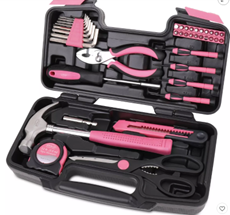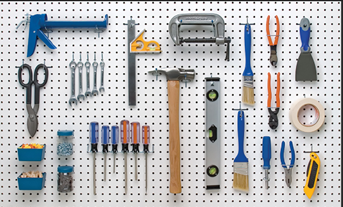The Ultimate Guide to Essential Tools for Women Homeowners
An ultimate guide to the basic tools women homeowners should have
Donna Bell
8/19/20245 min read
The Ultimate Guide to Essential Tools for Women Homeowners
If you are a woman who owns a home or is about to become a new homeowner, you may wonder what kinds of tools you’ll need to have on hand.
You may have gone to the big box store only to find yourself completely overwhelmed at just how many things there are. So much to choose from! And if you’re like me, I don’t know what half the tools even are!
Or maybe you’ve done an internet search for the best tools a homeowner needs and seen something super cute, like this:
This tool kit is great. Maybe. If you live in an apartment. But there’s absolutely no reason to have pink tools (or any other “feminine” color).
If you really want pink tools, that’s fine, but please understand that quality tools are more important than cute tools. Save the cuteness for your trendy new nail polish. Tools need to be functional!
So, what do you need as a woman who owns, or is about to own, her own house? What do you look for when buying tools?
This guide is designed to give you an overview of the basic tools you’ll really need as a woman who owns a home or is about to become a homeowner.
Ready? Great. Let’s look past the cutesy ads and dive into what you really need.
1. The Right Weight and Size
Tools need to be heavy-duty enough to perform the job, but not so heavy that you can’t manage them.
Lightweight is great, but if that hammer only weighs eight ounces and you’ve got a big project, you’re going to expend an awful lot of your own energy trying to get the job done. On the other hand, you don’t want a tool that’s so oversized that you hurt yourself trying to lift it or use it.
This might take a trial-and-error approach, so if you’re not sure what size/weight you’re comfortable using, I would suggest borrowing the tool in question or renting it first.
You can usually find a tool rental section in the big-box store and at some smaller hardware stores. Check your local library, too. Some libraries have a lending section for tools.
2. Quality Matters
Buy the highest quality tools you can afford. This goes along with the previous point. The most expensive does not necessarily mean the best quality.
You don’t need a socket wrench that can sing the National Anthem, do a polka, and explain quantum computing. Buy a tool that does what you need it to do.
Don’t pay extra money for features that you don’t need. But again, do buy the highest quality that you can afford.
My father used to love to buy his tools at the bargain outlet store. “Why spend 100 dollars on a drill if I can buy one for $25?” was his logic. But that tool was usually only good for a year or two.
It was an oft-repeated scene. Dad has a project and needs the power drill, gets it out and gets ready to use it, only to find that it inexplicably no longer works.
This led to a lot of cursing, followed by a trip back up to the bargain outlet store for another cheap power drill.
After years of repeatedly replacing those crappy tools, he finally listened to his family and invested in some higher-quality tools.
Don’t be my dad. Invest in the best tools that you can afford. Your kids will thank you for it.
3. Organization is Key
If you don’t use tools very often, chances are that you won’t remember whether your socket wrench is American vs metric or whether those bits are for your cordless drill or your impact driver.
Keeping your tools organized can save you a lot of time and frustration.
Even if you only have a drawer, a dedicated space for your tools is important so that you don’t waste time looking for what you need.
And if you have room on a basement, garage or shed wall to install some pegboard, you can keep your tools organized, in sight, and labeled, like this:
Here are some essential tools every (woman) homeowner should have:
Tape Measure: For measuring spaces, furniture, and more.
Hammer: A 16 oz. hammer with a comfortable grip is perfect for driving and removing nails and can also be used for minor demolition.
Screwdrivers: A set of both flat-head and Phillips-head screwdrivers in assorted sizes.
Pliers: Including needle-nose and locking pliers for gripping, bending, and cutting wires.
Wrench: Adjustable wrenches are useful for tightening or loosening nuts and bolts.
Extension Cords: For powering tools and other devices.
Tarps: Useful for protecting surfaces and containing debris.
Wire Cutters: For cutting wires and cables.
Drills and Drill Bits: A power drill with a variety of bits. You can choose between cordless, which is powered by a lithium battery, or corded. Cordless drills usually come with a charger and at least one battery. Corded drills are powered by electricity. Cordless drills are a popular choice since they aren’t restricted by cord length, and it doesn’t take much time to charge the battery.
Socket Wrench Set: For loosening, tightening, or removing nuts and bolts. A socket wrench is like a standard wrench, but it has a ratcheting design that makes it easier to turn (higher torque), which means less strain and fatigue on you.
Pry Bars: For removing nails and prying apart materials.
Bucket: At least a one-gallon bucket for carrying tools and materials or for cleaning projects.
Rags: For cleaning up spills and messes.
Outdoor Tools
Lawn Mower
Wheelbarrow or Cart: For moving heavy items around your yard.
Chainsaw or Hand Saw: Needed for removal of branches and/or trees.
Hedge Trimmer or Pruning Shears: For keeping shrubs and bushes neat.
Shovel: For bashing moles that are tearing up your yard. And digging.
Rake: For raking up leaves and grass.
Sanding Tools: For removing paint/varnish and smoothing surfaces.
Emergency Supplies
Fire Extinguisher: A must-have for any home.
First Aid Kit: For treating minor injuries.
Flashlights and Batteries: Essential during power outages.
Emergency Contact List: Keep a list of important phone numbers handy.
Miscellaneous Items
Extension Cords: For powering tools and appliances.
Duct Tape: For quick fixes and temporary repairs.
Zip Ties: Useful for bundling cables and securing items.
Utility Knife: For cutting materials like cardboard and plastic.
Extra Blades for Utility Knife
Safety Gear
Glasses or Goggles: To protect your eyes.
Ear Protection: Plugs or other forms of ear protection for loud tasks.
Work Gloves: To protect your hands while working.
Dust Mask or Respirator: To prevent breathing harmful fumes or particulates.
Work bench or worktable: For projects that involve a large, flat work surface.
Don’t forget to clean your tools after you use them and put them back in their designated space so they’re ready to go the next time you need them.
By investing in quality tools and keeping them clean and organized, you’ll be well-prepared to tackle any home improvement project that comes your way.
Remember, the right tools can make all the difference in the ease and success of your projects.
Keep in mind that this guide to the tools a woman needs around the house is just a starting point-lots of household projects, such as painting a room or tackling a plumbing project, will require the use of various other specialty tools.
But now you’ve got the essentials, so get your tools and DIY with confidence!




